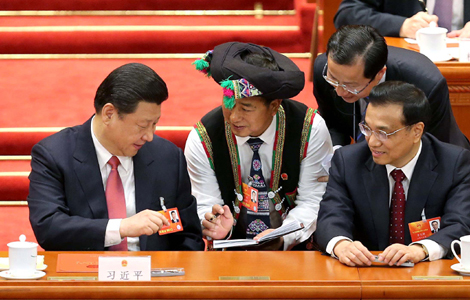Full text: Report on China's economic, social development plan
Updated: 2013-03-19 20:224. We speeded up adjustment to the economic structure.
Fresh progress was made in scientific and technological innovation and development of high-technology industries. We introduced guidelines on deepening reform of the management system for science and technology and accelerating development of a national innovation system, and promulgated and implemented the plan to develop strategic emerging industries in the Twelfth Five-Year Plan period. Spending on R&D as a percentage of GDP reached 1.97%. New economic growth areas such as biomedicine, online information services, and ocean engineering equipment grew rapidly. Value-added of high-tech manufacturing industries grew 12.2%, 2.2 percentage points higher than the growth rate of value-added of large industries. Transformation and upgrading of traditional industries progressed further, projects to relocate some major coastal steel bases and steel mills in cities were launched, and the proportion of new dry-process cement reached over 90% of total cement output. Enterprise mergers and reorganizations continued to make progress, and fresh results were achieved in closing down outdated production facilities. We made progress in developing the service sector and quickly developed producer and consumer services. Value-added of the service sector increased 8.1%, 0.2 percentage points higher than the planned target, and this sector continued to rank first in employing people. Transportation infrastructure and energy production are now better able to meet demand. We put into operation 5,382 kilometers of new railway lines, including 2,723 kilometers of high-speed railway lines; opened 58,672 kilometers of new highways to traffic, including 9,910 kilometers of expressways; put into service 96 seaport berths for 10,000 ton-class or larger ships; and built two new civilian airports. We intensified construction of large energy production bases, and accelerated development of green mining and the comprehensive upgrading and renovation of coal-fired power plants. The installed power-generating capacity of on-grid wind power and photovoltaic power facilities increased 15 million kilowatts and 3 million kilowatts, respectively. The output of raw coal, crude oil, and natural gas rose by 3.8%, 2.3%, and 4.4% year on year, respectively. Electricity production increased by 4.8%.
Regional development became better balanced. Construction began on 22 more major projects for the large-scale development of the western region, with a total investment of 577.8 billion yuan. Intensive pairing assistance was provided to Xinjiang, Tibet, and Tibetan ethnic areas in Sichuan, Yunnan, Gansu, and Qinghai provinces; the inland and border areas were opened wider to the outside world; and the reconstruction in Yushu, Qinghai, registered steady progress, and came to a successful end in Zhugqu, Gansu. We opened northeast China wider to the outside world. We achieved notable progress in ecological conservation and economic transformation in forest regions, and made coordinated efforts to promote transformation and upgrading of old industrial bases and sustainable development of resource-dependent cities and industrial and mining areas. We introduced the guidelines on the strategy for energizing development of the central region, and made significant progress in developing three different types of production bases and a system of integrated transportation hubs in the region. The central and western regions maintained powerful momentum in receiving industries relocated to them. The eastern region picked up speed in taking the lead in development and economic transformation. The Beijing-Tianjin-Hebei region and the Yangtze River and Pearl River deltas greatly improved the quality of their development. The pilot project to develop the marine economy proceeded smoothly. The functional zoning strategy was implemented thoroughly, with the central government increasing its transfer payments to national functional ecological zones of key importance by 23.7%, and with provincial-level plans being basically linked and coordinated with the national strategy. We increased support to old revolutionary base areas, ethnic minority areas, and border areas; and vigorously promoted poverty alleviation and development in contiguous areas with acute difficulties. We relocated 1.95 million impoverished rural residents from inhospitable areas, exceeding the planned target by more than 900,000. China's urbanization rate reached 52.57%, 0.5 percentage points higher than the targeted figure.


